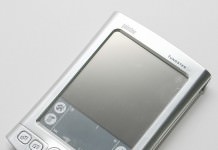 Last night I re-posted a great essay from my good friend Eric Burns-White of Websnark (we wrote for the same Internet fiction writing circle during our college days). In his essay, he responded to another essay by his niece Hadley Gibson about how much better paper books are than e-books.
Last night I re-posted a great essay from my good friend Eric Burns-White of Websnark (we wrote for the same Internet fiction writing circle during our college days). In his essay, he responded to another essay by his niece Hadley Gibson about how much better paper books are than e-books.
Both essays are terrific examples of their respective archetypes. Gibson’s epitomizes the complaint of many bibliophiles that e-books simply don’t have the paper aesthetic they prefer, while Burns-White’s praises e-books’ portability and other advantages. (Though to simplify them in such a way is to do them both a mild disservice.) But beyond that, they both got me thinking.
Going by the education dates on her LinkedIn Profile, I’m estimating that Gibson is about 19 years younger than I am, but her complaints against e-books were the sort of thing I would expect to see from the generation older than me. (Indeed, after hearing from my Mom about Burns-White’s essay, my Dad e-mailed me to ask if he had addressed the way e-books don’t make it easy to flip back to a specific point to refresh his failing memory, the way he can in a paper book. I’m still not sure quite how to reply to that.)
But Gibson is far from alone in her generation. FutureBook writes that a lot of younger people seem to prefer reading paper books. The article cites a survey showing that 75% of readers younger than 17 want their favorite stories available in print. Similar articles can be found at BoingBoing (citing a book from Oxford University Press and an article from Jeff Bezos’s Washington Post) and Digital Book World.
The articles offer a number of reasons or rationalizations that make sense for younger readers, such as being able to build a physical map of a book helping them with comprehension (that “flipping back to an earlier section” thing again), or the propensity to be easily distracted by things on electronic screens. It’s interesting to me that screen distraction is such a problem, as I would have expected a generation that lives much of their lives in social media to prefer to read books that way, too. But perhaps that’s also part of the reason they’re attracted to paper—compared to the digital screens that make up the majority of their lives now, it’s actually refreshingly different to read something on paper. (It’s kind of funny to put it that way, because for me that was part of e-books’ original appeal to me—it was refreshingly different to read something that wasn’t on paper!)
It’s a generalization, to be sure, and every member of the generation will have their own individual tastes—there will be young people who do prefer e-books, and people of my generation who prefer print—but it makes me think about the conventional wisdom that generations tend to reject the values of their parents. It’s said that Republican parents will tend to have kids who go Democrat and vice versa, and so on. Are e-books another example of that? Kids like me whose parents read paper gravitated toward e-books, whereas kids whose parents (or their parents’ siblings) read e-books themselves prefer paper?
I can’t say I ever thought of paper versus electronic reading being a touchstone of teen rebellion, but it does seem to fit. Either way, it helps cast doubt on the idea that e-books will ever “replace” paper completely, and could also explain the resurgence of paper bookstores. But I suppose we’ll have to wait another twenty years to find out whether their kids prefer e-books again.
On the other hand, at least it’s a good thing when teens and young adults express a preference for reading at all.
(Time stamp changed to allow for more prominent display during a peak traffic time. – D.R.)


































I doubt age has much to do with this except at the margins, such as:
* Small children who like physical books with pictures and pages they can turn. That’s easily seen.
* Some older adults who have seen so much technological change in their lives that they’ve rebelled against more, particularly when it doesn’t seem to be an improvement. My parents were like that. They were born on farms without electric lighting. They drew the line at computers.
—–
The real distinction is probably like that between people who dine at fast-food restaurants and those who eat at expensive ones. No one minds that MacDonalds serves food in disposable containers. That fits with a quick eat. On the other hand, someone who is spending a couple of hundred dollars to dine at an elegant French restaurant will get upset if they aren’t served on fine china. They want that memorable event to really be memorable in every way.
In much the same way, people who’re going through several books a week reading the literary equivalent of fast food, quickly done thrillers and romances, doesn’t care about the package. Their books are quickly read, easily discarded and soon forgotten. Digital is fine. Cheap digital books on cheap Kindle ereaders are even better.
On the other hand, those for whom the reading is serious want something better. That ranges from students with important textbooks (i.e. in medical and nursing schools) to great novels and thought-stimulating non-fiction. These people do care about the packaging. They want to remember the book and perhaps consult it later. For that, print not only makes sense, but they want carefully done books, perhaps even hardbacks. It isn’t junk, so it should not look like junk.
That’s true even when we already have the books. Two of my favorite books are J. R. R. Tolkien’s The Lord of the Rings and C. S. Forester’s The Good Shepherd. I already had them in paperback, but they mean enough I deliberately bought hardback versions.
The real distinction, that hardback print means permanence and quality while digital doesn’t mean either may or may not disappear with time. Companies such as Amazon certainly aren’t doing anything to equate digital with quality. But at presence, that distinction is part of what’s going through people’s minds when they talk about the feel and smell of books and the seeming impermanence and limited value of what’s on the screen of the ereader they own this year.
There’s also the collector’s aspect to print that can’t exist with digital. Just yesterday, I discovered that the copy of Eric Maria Remaques’s All Quiet on the Western Front that I picked up a few months back is the second printing of the first U.S. edition. It’s perhaps not quite as special as the first printing of the first edition, but it is a bit special. The original 1929 owner was someone who well-remembered and perhaps even fought in the First World War. That’s a connection with the past that no digital book can provide.
The title of this article caught my eye when it showed up in my feedly account next to a comic strip from Unshelved. This week has featured a series of strips depicting an adult and child at the library and the adult wants the child to find a “real” book but the child is already reading a book on a mobile device.
The series starts at http://www.unshelved.com/2015-10-5.
The adult argues that reading on a phone isn’t reading (http://www.unshelved.com/2015-10-6).
The librarian rebuts that books are format-neutral (http://www.unshelved.com/2015-10-7).
The child just downloads another book and continues reading (http://www.unshelved.com/2015-10-8).
It’s interesting to me that screen distraction is such a problem
Distraction becomes a greater problem as you graduate from an exclusive e-reader to a tablet or smart phone, which have a greater variety of distractions- and more easily accessed distractions- compared to an e-reader. I am reminded of my sister, who told me that she prefers a tablet instead of an e-reader so she can more readily check her e-mail on her reading device. By contrast, one reason for my preferring an e-reader is that it is much more difficult to check e-mail on an e-reader, given that most e-reader browsers aren’t that good.
An easy way to deal with distractions is to turn off the wireless.
I wonder if the 17 year olds will change their minds by the time they are 47?
After moving house multiple times, having their paper books lost, stolen, or damaged, and looking forward to downsizing their homes after their kids move out, they may not be as enamoured with paper books as they once were.
This may be an age related choice that will apply generation after generation.
Either or is not the way to approach the situation. It is more a case of what is appropriate or a better choice in a given situation for a particular book.
I have far too many dead tree books. I prefer to buy most new books as e-books. Exceptions are some cook books with lots of pictures and some technical books and some reference books.
Novels, I prefer the e-book as it is easier to carry a number of them with me to read wherever I am. Availability of the book in electronic form makes many books available that I cannot find in hard copy or are excessively expensive. Sometimes I can find a used hard copy, but many are available as e-books.
I read on a Kindle e-ink reader as well as a Kindle Fire HDX 8.9. I find the differences between the two interesting. The HDX provides a good experience reading cookbooks and other graphics intensive books as well as PDF files. For text, I prefer my Paperwhite. Navigation within a book varies and is a bit more awkward on e-books, but much of that is that it is not a obvious as flipping pages and I didn’t grow up using it.
Most important is using whatever gives you a good reading experience for any book.
I wonder how young people will feel about paper books once they need reading glasses! It was not an accident that a lot of early Kindle buyers were folks well over 50.